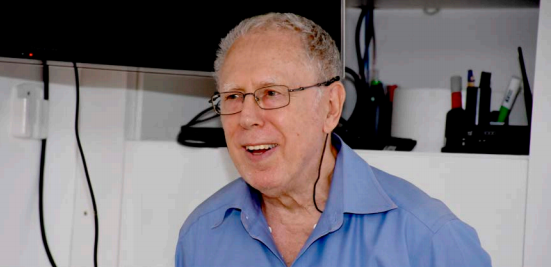Dan Marchesin: Half a century at the forefront of Computational Mathematics

The field of mathematics has always encompassed a broad range of ideas, from the practical to the abstract. Euclid’s geometry theorems arose ultimately from the problem of measuring farmland, and Newton’s calculus was motivated by questions about motion and gravity and enabled celestial predictions. Mathematics has also been inspired by detailed exploratory calculations. Gauss (when only 15 or 16) used a table of logarithms to count prime numbers and was led to conjecture the prime number theorem.
In the twentieth century, mathematics received great impetus by the increasing pace of scientific and technological development. The last half-century has seen the stupendous transformation of society by networked digital computers; mathematics has likewise been transformed, in the questions it seeks to answer, in the manner of communication and collaboration among mathematicians, and in the depth to which it is guided by computational exploration.
Dan Marchesin, who turned 70 this year, has been at the forefront of computational mathematics ever since he typed programs onto stacks of punched cards at the Courant Institute of Mathematical Sciences at New York University. (Dan relates that he learned a bitter lesson when he once dropped a program stack: number the cards!) His productive research career, which has focused on fluid dynamics, exemplifies the fruitful interplay among abstract mathematics, computational experiment, and difficult technological challenges.
Sophisticated application of mathematics to fluid dynamics dates from the time of Newton, D. Bernoulli, and Euler. A century ago, a surge in progress was sparked by the invention of airplanes and rockets. (This progress included prescient analysis of novel “finite difference” methods for simulating fluid flow, only later implemented on computers.) Many advances in fluid dynamics are founded upon the contributions of Courant, Friedrichs, Isaacson, Gelfand, Oleinik, Lax, and Glimm to the mathematical theory of conservation laws. (In essence, fluid flow is governed by the laws of conservation of mass, momentum, and energy.) The importance of this theory swelled when powerful computers became common and computational fluid dynamics became an essential tool in many areas of engineering. Dan began his scientific career at this time and has contributed notably to this growth.
Dan Marchesin was born in Bucharest, Romania, in 1947. Dan is married to Miyoko Ohtani, who has been wonderfully supportive of his scientific work, and they have one son Andrew, who is a successful engineer.
When he was very young, Dan and his family lived in Italy; after a short period spent in France, they moved to Rio de Janeiro, Brazil, in 1956. Ever since his early childhood, Dan has had an intense interest in science. This fascination motivated him to begin his college career at the Pontifical Catholic University of Rio de Janeiro (PUC-Rio) studying in the Physics Department while simultaneously studying mathematics. He graduated with a Bachelor’s degree at the age of 23 and later earned his Master’s degree in Mathematical Physics from the Mathematics Department at PUC-Rio.
Dan continued his studies in the doctoral program at the Courant Institute. He completed his Ph.D. in 1978 under the guidance of the outstanding mathematician James Glimm. At this time he began to study fluid dynamics using computers, which were only then becoming accessible to researchers at universities. During his postdoctoral studies at the Rockefeller University, the Courant Institute, and the Goddard Space Flight Center of NASA, Dan acquired expertise in numerical weather forecasting and in the flow of oil and brine through porous rock in petroleum reservoirs.
Dan, Miyoko, and Andrew returned to Brazil in 1980. As a young professor at PUC-Rio, Dan initiated inter-disciplinary postgraduate education in the field of Applied Mathematics. As throughout his career, he participated actively in the training of students as scientific researchers and in advancing new areas of application of mathematics.
Dan continued his scientific research at the Instituto de Matemática Pura e Aplicada (IMPA) after moving there in 1987. He founded the Laboratory of Fluid Dynamics and a program of study in this field that includes early undergraduate through post-doctoral students. While at IMPA, Dan has supervised the Applied Mathematics theses of 20 Ph.D. and 18 Master’s degree students (out of a total of 46 and 53, respectively, at the Laboratory of Fluid Dynamics), and he has initiated numerous undergraduate students in scientific research with clever mathematical and computational tasks.
Among Dan Marchesin’s many lasting contributions to science are the following:
• His extensive and detailed study of fundamental solutions of the equations governing three-phase immiscible flow in a porous medium. These solutions, or waves, serve as building blocks of general flows. He has elucidated the properties of such waves using an uncommon scientific approach: focusing attention not on simplified models but rather on a difficult realistic model that exhibits the full spectrum of complicated behavior.
• His discovery, in collaboration with colleagues, of the existence of a new type of wave in three-phase porous medium flow. This new wave clarifies the efficacy of modern enhanced oil recovery techniques.
• His contributions to an array of mathematical and computational specialties through work on concrete applications, from partial differential equations and dynamical system to numerical analysis and computer graphics.
• His development of mathematical and computational tools for solving and understanding fundamental solutions in fluid dynamics, ranging from the abstract (the wave manifold and bifurcation theory) to the practical (parallel computer methods for solving highly non-linear equations).
• His recent deduction of the mathematical structure of compositional models of geo-chemical flows and improved understanding of enhanced oil recovery methods based on injecting brine and carbon dioxide. Dan has published more than one hundred papers in international scientific journals on various topics: in addition to the aforementioned results, he has reported work on computational aspects of quantum field theory, simulation and analysis of laser ionization, efficient numerical methods for weather prediction, and numerical methods for flows containing discontinuous waves.
Dan is well known for his heartfelt loyalty and friendship. We, his numerous students, colleagues, and friends, congratulate Dan on his scientific accomplishments and anticipate his continued success.


